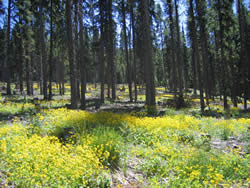Forests and Rangelands Success Story
Stewardship Project Hopes to Save Ghost Towns from Catastrophic Wildfire
Missoula Field Office, Montana
National Fire Plan - Fuels Reduction
2008

Overview of Garnet showing beetle killed trees.
In late August of 2008, the Missoula Field Office began implementation of Phase II of the Garnet and Coloma Ghost Town Hazardous Fuel Reduction Project. Both towns, located east of Missoula, began in the 1890s as mining towns. During their heyday, the ghost towns had over a 1,000 residents. Today, Garnet and Coloma face a significant threat from wildfire due to heavy loading of dead and dying timber in the surrounding forest. In recent years, the rate of fuel buildup increased exponentially due to an infestation of mountain pine beetles. The mountain pine beetles have killed close to 90 percent of the lodge pole pine greater than five inch diameter at breast height (DBH) around Garnet and Coloma. Fortunately, Douglas fir and other species present in the area are not affected by the beetle infestation.
Since 2000, several large wildfires have threatened the ghost towns, including the Ryan Gulch Fire (2000) and the Packer Gulch Fire (2006). Without an effective, proactive plan to reduce the threat, a wildfire could devastate Garnet and Coloma, leaving important historic and cultural sites in ashes.
In 2006, the Missoula Field Office completed a 20-acre pilot project (Phase I), which successfully demonstrated that forest fuel load could be reduced without damaging cultural and historic features. Phase II planning included field office interdisciplinary team specialists, the Garnet Preservation Association, and adjacent private landowners. The objectives of the Phase II project include: reducing the risk of stand replacement wildfire near historic ghost town structures and cultural features; protecting inhabited private structures within and adjacent to the ghost towns; protecting multiple historic and cultural features during the fuel treatments; and providing enhanced recreational opportunities for the public by constructing new ADA-compliant interpretive trails.
Phase II will treat 304 acres surrounding the two towns in eleven different units. The treatment will include mechanical removal of trees by commercial thinning and removal of non-merchantable trees and slash for pulp. The project also includes constructing approximately two miles of new interpretive trails that will enhance visitor experiences by allowing access into new areas. In addition to fuels reduction on BLM-administered land, the collaborative project has stimulated local landowners with in-holdings in the project area to take action to reduce the wildfire threat.
The Missoula Field Office is utilizing the stewardship contracting authority to accomplish this work. Stewardship contracting allows the BLM to focus on desired results, such as minimizing disturbance to cultural features and allows the BLM to place less emphasis on contract stipulations and more emphasis on the final product. Stewardship contracting offered an opportunity to remove the fuel while benefiting other programs, such as recreation and archaeology interpretation.
When the project is completed, the view shed near Garnet will change — some may even find this change dramatic. However, the transformation to a more open forest greatly reduces the area’s susceptibility to catastrophic fire and creates a landscape much more typical of the area when Garnet was a booming mining camp.
Contact: Shelagh Fox, Missoula Field Office Fire Ecologist, 406-329-3909.